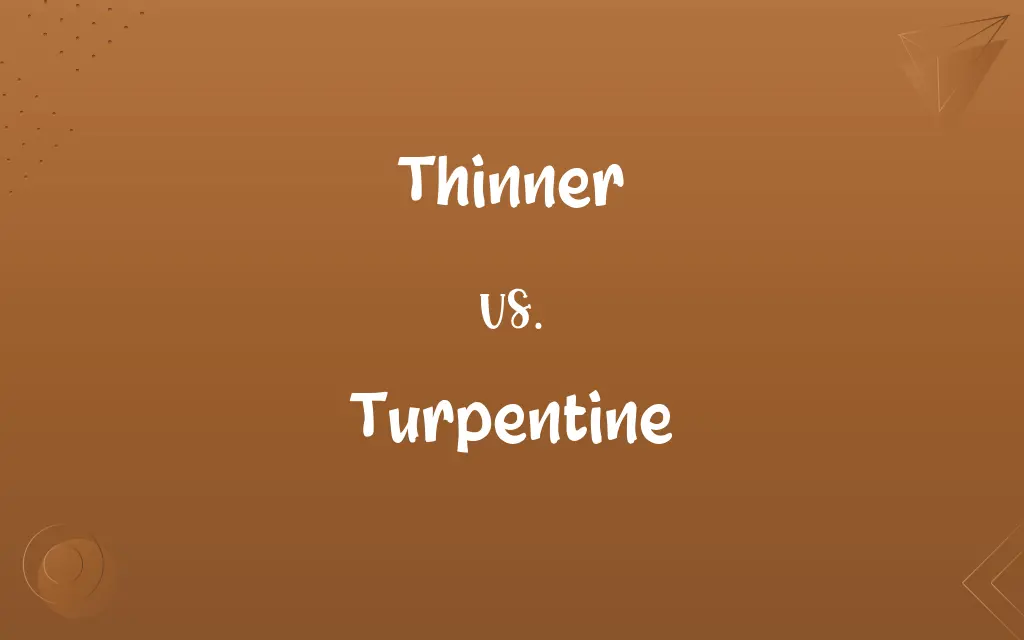Thinner vs. Turpentine: Know the Difference

By Shumaila Saeed & Hifza Nasir || Published on September 25, 2024
Thinner is a solvent used to dilute paint and clean brushes, varying in composition, while turpentine is a specific type of thinner derived from pine resin, known for its strong smell.

Key Differences
Thinner, a broad category of solvents, is designed for diluting paints and varnishes or cleaning painting equipment. Its composition can include a variety of chemicals, such as acetone, mineral spirits, or toluene, depending on the type of paint it's meant to thin. Turpentine, on the other hand, is specifically distilled from the resin of pine trees and has been traditionally used as a thinner and solvent for oil-based paints. Its distinctive pine scent sets it apart from other thinners.
Shumaila Saeed
Sep 25, 2024
Thinner can refer to any solvent that dilutes paint's viscosity, making it easier to apply or remove, turpentine is valued not just for its thinning properties but also for its role in producing a natural, glossy finish on painted surfaces. Turpentine's natural origin contrasts with many thinners that are synthetic or petroleum-based, offering a choice for those seeking more traditional or environmentally sensitive options.
Shumaila Saeed
Sep 25, 2024
Turpentine also plays a role in the arts, especially in oil painting, where its ability to dissolve paint without affecting color intensity is prized. Meanwhile, thinners like mineral spirits are preferred for their less toxic and odorous nature for general cleaning tasks. This distinction highlights the specific uses and preferences in different artistic and practical contexts.
Hifza Nasir
Sep 25, 2024
Despite turpentine's traditional popularity, concerns over its strong odor and potential health effects have led many to opt for alternatives like odorless mineral spirits. Thinner varieties are formulated to offer similar effectiveness with reduced health risks, showcasing the advancements in chemical engineering aimed at safer, more user-friendly products.
Hifza Nasir
Sep 25, 2024
Both thinner and turpentine are essential in painting and varnishing processes, yet their differences in composition, origin, and application underscore the importance of choosing the right solvent for the right task. Whether for artistic precision or practical efficiency, understanding these nuances ensures better results and safer practices.
Shumaila Saeed
Sep 25, 2024
ADVERTISEMENT
Comparison Chart
Definition
A solvent used to dilute paint and clean equipment
A specific type of thinner made from pine resin
Shumaila Saeed
Sep 25, 2024
Composition
Can vary (acetone, mineral spirits, toluene, etc.)
Distilled pine resin
Shumaila Saeed
Sep 25, 2024
Use
Diluting paint, cleaning brushes and equipment
Diluting oil-based paints, cleaning, artistic work
Shumaila Saeed
Sep 25, 2024
ADVERTISEMENT
Health Risks
Varies by chemical composition; some are less toxic
Potentially more toxic due to strong fumes
Dua Fatima
Sep 25, 2024
Environmental Impact
Depends on the chemical base; some are more environmentally friendly
Considered more natural but still can be harmful if not disposed of properly
Shumaila Saeed
Sep 25, 2024
Preferred Use
General painting and cleaning tasks
Traditional oil painting and varnishing
Dua Fatima
Sep 25, 2024
Thinner and Turpentine Definitions
Thinner
A solvent for reducing paint viscosity.
The painter used thinner to lighten the paint's texture.
Shumaila Saeed
Mar 04, 2024
Turpentine
A natural solvent from pine resin.
Turpentine was chosen for thinning the oil paint due to its quality.
Shumaila Saeed
Mar 04, 2024
ADVERTISEMENT
Thinner
Varies in composition for different applications.
The varnish required a specific type of thinner for dilution.
Shumaila Saeed
Mar 04, 2024
Turpentine
Can be more toxic due to fumes.
Adequate ventilation is necessary when using turpentine due to its potent fumes.
Shumaila Saeed
Mar 04, 2024
Thinner
Used for cleaning painting tools.
After painting, the brushes were cleaned with a specialized thinner.
Hifza Nasir
Mar 04, 2024
Turpentine
Traditionally used in oil painting.
Artists value turpentine for its ability to enhance paint's gloss.
Dua Fatima
Mar 04, 2024
Thinner
Essential for paint application and removal.
Thinner made the process of removing the old paint much easier.
Hifza Nasir
Mar 04, 2024
Turpentine
Used for cleaning brushes in art.
The oil paint brushes were meticulously cleaned with turpentine.
Shumaila Saeed
Mar 04, 2024
Thinner
May be synthetic or natural.
Natural thinner options are available for eco-conscious artists.
Shumaila Saeed
Mar 04, 2024
Turpentine
Known for its strong pine scent.
The studio was filled with the distinctive smell of turpentine.
Hifza Nasir
Mar 04, 2024
Thinner
A liquid substance used to thin the consistency of another liquid.
Turpentine or mineral spirits can be used as a thinner for oil-based paints.
Shumaila Saeed
Mar 03, 2024
Turpentine
A thin volatile terpenoid essential oil, C10H16, obtained by steam distillation or other means from the wood or exudate of certain pine trees and used as a paint thinner, solvent, and medicinally as a liniment. Also called oil of turpentine, spirit of turpentine.
Shumaila Saeed
Mar 03, 2024
Thinner
A liquid, such as turpentine, mixed with paint or varnish to reduce its viscosity and make it easier to apply.
Shumaila Saeed
Mar 03, 2024
Turpentine
The sticky mixture of resin and volatile oil from which turpentine is distilled.
Shumaila Saeed
Mar 03, 2024
Turpentine
(transitive) To drain resin from (a tree) for use in making turpentine.
Hifza Nasir
Mar 03, 2024
Turpentine
A volatile essential oil now obtained from such oleoresin of from the wood of pine trees by steam distillation; a complex mixture of monoterpenes; now used as a solvent and paint thinner.
Shumaila Saeed
Mar 03, 2024
Turpentine
A semifluid or fluid oleoresin, primarily the exudation of the terebinth, or turpentine, tree (Pistacia Terebinthus), a native of the Mediterranean region. It is also obtained from many coniferous trees, especially species of pine, larch, and fir.
Shumaila Saeed
Mar 03, 2024
Turpentine
Volatile liquid distilled from turpentine oleoresin; used as paint thinner and solvent and medicinally
Shumaila Saeed
Mar 03, 2024
Repeatedly Asked Queries
Is turpentine more toxic than other thinners?
Turpentine can be more toxic due to its strong fumes, necessitating proper ventilation and protective measures during use.
Shumaila Saeed
Sep 25, 2024
Can turpentine be used as a thinner for all types of paint?
Turpentine is best suited for oil-based paints due to its properties and may not be compatible with water-based or acrylic paints.
Shumaila Saeed
Sep 25, 2024
Why choose turpentine over other thinners?
Artists may prefer turpentine for its natural composition and the unique glossy finish it imparts to oil paintings.
Shumaila Saeed
Sep 25, 2024
What is turpentine?
Turpentine is a specific type of thinner derived from pine resin, traditionally used for thinning oil-based paints and cleaning brushes.
Shumaila Saeed
Sep 25, 2024
What is thinner?
Thinner is a general term for solvents used to dilute paint and clean painting equipment, with a composition that varies based on intended use.
Hifza Nasir
Sep 25, 2024
Is turpentine environmentally friendly?
While turpentine is derived from natural sources, it still requires careful disposal to minimize environmental harm.
Hifza Nasir
Sep 25, 2024
Are there odorless alternatives to turpentine?
Yes, odorless mineral spirits are available as less toxic and odorless alternatives to turpentine for those sensitive to its strong scent.
Shumaila Saeed
Sep 25, 2024
What precautions should be taken when using turpentine?
Use turpentine in a well-ventilated area, wear protective gloves, and avoid direct inhalation of the fumes to reduce health risks.
Dua Fatima
Sep 25, 2024
How should turpentine be disposed of?
Turpentine should be disposed of according to local hazardous waste regulations due to its potential environmental impact.
Dua Fatima
Sep 25, 2024
Can I use household items as a thinner instead of turpentine?
Household items are generally not recommended as substitutes for professional thinners or turpentine in painting and cleaning tasks.
Shumaila Saeed
Sep 25, 2024
Can thinner be used for purposes other than painting?
Yes, thinner can also be used for cleaning surfaces, removing stains, and in various industrial applications.
Shumaila Saeed
Sep 25, 2024
What are the signs of turpentine overexposure?
Symptoms of overexposure include headache, dizziness, nausea, and irritation of the eyes, skin, and respiratory system.
Shumaila Saeed
Sep 25, 2024
How do I choose the right thinner for my paint?
The choice of thinner depends on the type of paint (oil-based, acrylic, etc.) and the desired viscosity or cleaning requirement.
Hifza Nasir
Sep 25, 2024
Is turpentine more expensive than synthetic thinners?
Turpentine can be more expensive than some synthetic thinners due to its natural origin and traditional extraction process.
Shumaila Saeed
Sep 25, 2024
Can turpentine affect the color of the paint?
Turpentine does not typically affect the color of oil-based paints and is valued for maintaining the intensity of pigments.
Shumaila Saeed
Sep 25, 2024
Share this page
Link for your blog / website
HTML
Link to share via messenger
About Author
Written by
Shumaila SaeedShumaila Saeed, an expert content creator with 6 years of experience, specializes in distilling complex topics into easily digestible comparisons, shining a light on the nuances that both inform and educate readers with clarity and accuracy.
Co-written by
Hifza Nasir







































































